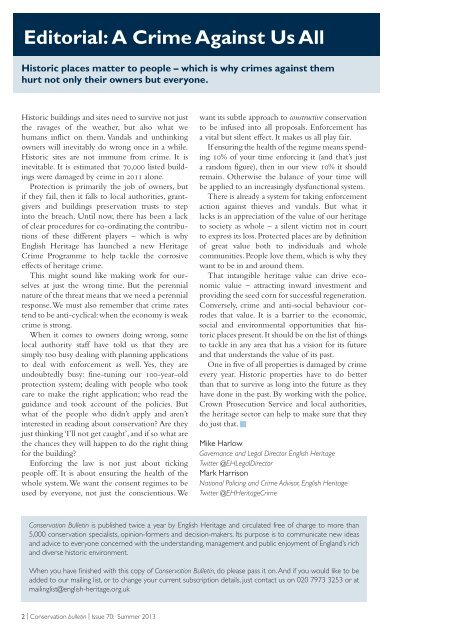Conservation Bulletin 70 | PDF - English Heritage
Conservation Bulletin 70 | PDF - English Heritage
Conservation Bulletin 70 | PDF - English Heritage
You also want an ePaper? Increase the reach of your titles
YUMPU automatically turns print PDFs into web optimized ePapers that Google loves.
Editorial: A Crime Against Us All<br />
Historic places matter to people – which is why crimes against them<br />
hurt not only their owners but everyone.<br />
Historic buildings and sites need to survive not just<br />
the ravages of the weather, but also what we<br />
humans inflict on them. Vandals and unthinking<br />
owners will inevitably do wrong once in a while.<br />
Historic sites are not immune from crime. It is<br />
inevitable. It is estimated that <strong>70</strong>,000 listed buildings<br />
were damaged by crime in 2011 alone.<br />
Protection is primarily the job of owners, but<br />
if they fail, then it falls to local authorities, grantgivers<br />
and buildings preservation trusts to step<br />
into the breach. Until now, there has been a lack<br />
of clear procedures for co-ordinating the contributions<br />
of these different players – which is why<br />
<strong>English</strong> <strong>Heritage</strong> has launched a new <strong>Heritage</strong><br />
Crime Programme to help tackle the corrosive<br />
effects of heritage crime.<br />
This might sound like making work for ourselves<br />
at just the wrong time. But the perennial<br />
nature of the threat means that we need a perennial<br />
response.We must also remember that crime rates<br />
tend to be anti-cyclical: when the economy is weak<br />
crime is strong.<br />
When it comes to owners doing wrong, some<br />
local authority staff have told us that they are<br />
simply too busy dealing with planning applications<br />
to deal with enforcement as well. Yes, they are<br />
undoubtedly busy: fine-tuning our 100-year-old<br />
protection system; dealing with people who took<br />
care to make the right application; who read the<br />
guidance and took account of the policies. But<br />
what of the people who didn’t apply and aren’t<br />
interested in reading about conservation? Are they<br />
just thinking ‘I’ll not get caught’, and if so what are<br />
the chances they will happen to do the right thing<br />
for the building?<br />
Enforcing the law is not just about ticking<br />
people off. It is about ensuring the health of the<br />
whole system.We want the consent regimes to be<br />
used by everyone, not just the conscientious. We<br />
want its subtle approach to constructive conservation<br />
to be infused into all proposals. Enforcement has<br />
a vital but silent effect. It makes us all play fair.<br />
If ensuring the health of the regime means spending<br />
10% of your time enforcing it (and that’s just<br />
a random figure), then in our view 10% it should<br />
remain. Otherwise the balance of your time will<br />
be applied to an increasingly dysfunctional system.<br />
There is already a system for taking enforcement<br />
action against thieves and vandals. But what it<br />
lacks is an appreciation of the value of our heritage<br />
to society as whole – a silent victim not in court<br />
to express its loss. Protected places are by definition<br />
of great value both to individuals and whole<br />
communities. People love them, which is why they<br />
want to be in and around them.<br />
That intangible heritage value can drive economic<br />
value – attracting inward investment and<br />
providing the seed corn for successful regeneration.<br />
Conversely, crime and anti-social behaviour corrodes<br />
that value. It is a barrier to the economic,<br />
social and environmental opportunities that historic<br />
places present. It should be on the list of things<br />
to tackle in any area that has a vision for its future<br />
and that understands the value of its past.<br />
One in five of all properties is damaged by crime<br />
every year. Historic properties have to do better<br />
than that to survive as long into the future as they<br />
have done in the past. By working with the police,<br />
Crown Prosecution Service and local authorities,<br />
the heritage sector can help to make sure that they<br />
do just that. ■<br />
Mike Harlow<br />
Governance and Legal Director <strong>English</strong> <strong>Heritage</strong><br />
Twitter @EHLegalDirector<br />
Mark Harrison<br />
National Policing and Crime Advisor, <strong>English</strong> <strong>Heritage</strong><br />
Twitter @EH<strong>Heritage</strong>Crime<br />
<strong>Conservation</strong> <strong>Bulletin</strong> is published twice a year by <strong>English</strong> <strong>Heritage</strong> and circulated free of charge to more than<br />
5,000 conservation specialists, opinion-formers and decision-makers. Its purpose is to communicate new ideas<br />
and advice to everyone concerned with the understanding, management and public enjoyment of England’s rich<br />
and diverse historic environment.<br />
When you have finished with this copy of <strong>Conservation</strong> <strong>Bulletin</strong>, do please pass it on. And if you would like to be<br />
added to our mailing list, or to change your current subscription details, just contact us on 020 7973 3253 or at<br />
mailinglist@english-heritage.org.uk<br />
2 | <strong>Conservation</strong> bulletin | Issue <strong>70</strong>: Summer 2013

















